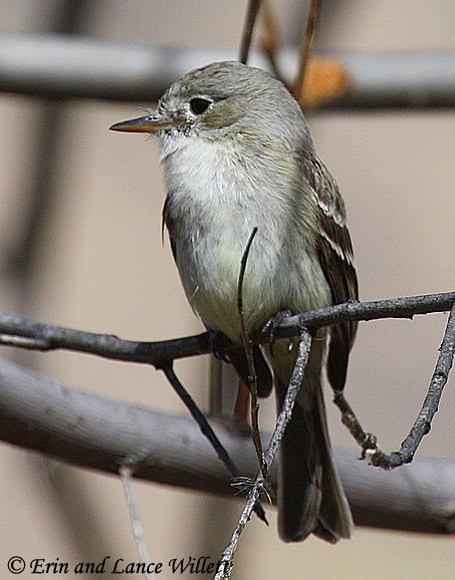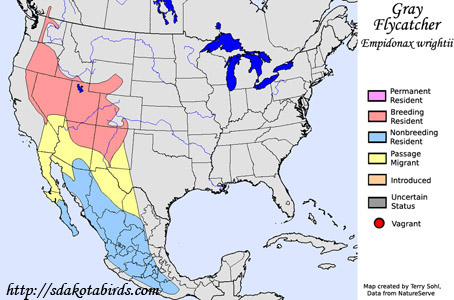| Length: 6 inches | Wingspan: 8.5 inches | Seasonality: Non-resident in South Dakota |
| ID Keys: Gray overall plumage, darker wings with two white wingbars, long tail with white outer edges | ||
 The
Gray Flycatcher is the largest of the "Empidonax" flycatchers, but is very
similar in appearance to some other western flycatchers, particularly the
Dusky Flycatcher and the
Hammond's Flycatcher. They
are shorter distance migrants than the other Empidonax flycatchers and
winter further north than the other species. They are most often found
in arid shrublands, such as sagebrush flats or open pinyon and juniper
woodlands.
The
Gray Flycatcher is the largest of the "Empidonax" flycatchers, but is very
similar in appearance to some other western flycatchers, particularly the
Dusky Flycatcher and the
Hammond's Flycatcher. They
are shorter distance migrants than the other Empidonax flycatchers and
winter further north than the other species. They are most often found
in arid shrublands, such as sagebrush flats or open pinyon and juniper
woodlands.
Habitat: Found in open, arid habitats of the western United States in summer, with most found in sagebrush flats. They winter in mesquite groves and other areas of lowland shrubs and trees.
Diet: Feds on insects and spiders.
Behavior: Forages by observing from a perch, and flying out to capture insects. They will catch insects in mid-air, by hovering and gleaning insects from foliage, and by grabbing them off the ground. They usually forage relatively close to the ground.
Nesting: The nest of a Gray Flycatcher is a deep cup built of grasses, twigs, strips of bark, weed stems, and other material, lined with softer materials such as feathers and plant down. The female usually lays 3 or 4 eggs, and she alone incubates them. When the eggs hatch, both parents help feed the young. The young fledge after about 17 days.
Song: Song of a Gray Flycatcher is two very distinct and different phrases, a rough grrrrrr and a high whistling pidoo.
Migration: Doesn't migrate as far a distance as most other Empidonax flycatchers, with most birds breeding in the western U.S. in summer, and wintering in western Mexico.
Interactive eBird Map: Click here to access an interactive eBird map of Gray Flycatcher sightings
Similar Species: Dusky Flycatcher, Hammond's Flycatcher, Willow Flycatcher
Conservation Status: Populations are found over a wide geographic region, they are common in parts of their range, and overall numbers may be increasing. The IUCN lists the Gray Flycatcher as a species of "Least Concern".
Further Information: 1) BirdWeb.org - Gray Flycatcher
2) Texas Breeding Bird Atlas - Gray Flycatcher
3) WhatBird - Gray Flycatcher
Photo Information: Photo taken by Erin and Lance Willett - Photo licensed under Creative Commons Attribution NonCommercial NoDerivs 2.0 Generic License.
| Click below for a higher-resolution map |
 |
| South Dakota Status: Non-resident in South Dakota |
Additional Gray Flycatcher Photos (coming soon!!)
